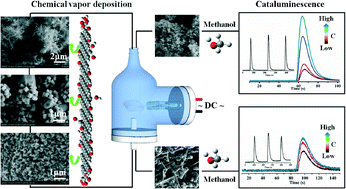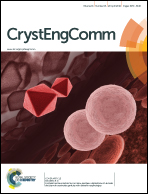Hierarchical SnO2 architectures: controllable growth on graphene by atmospheric pressure chemical vapour deposition and application in cataluminescence gas sensor†
Abstract
A facile catalyst-free atmospheric pressure chemical vapour deposition (APCVD) method for the growth of hierarchical SnO2 architectures on graphene is demonstrated. SnO2 2D nanorod arrays, flower@column composites, dendrite structures, and nanoparticles grown on graphene, named as SnO2/graphene architectures, were synthesized on Thermally-Reduced Graphene Oxide (TRGO) and Chemically-Reduced Graphene Oxide (CRGO), respectively. According to characterizations, the rutile SnO2 architectures had large-area uniformity and high crystallinity, which were highly densely and uniformly grown on graphene. A self-catalyzed vapor–solid (VS) and a self-catalyzed vapor–liquid–solid (VLS) mechanisms were proposed based on the detailed observation on the growth behaviour of the SnO2/graphene materials. The synthesized SnO2/graphene materials were directly used to construct gas sensors for methanol detection based on the cataluminescence (CTL) emission. Further study indicated that the SnO2/graphene materials showed enhanced CTL response to methanol and a morphology-dependent CTL performance. And then a fast and highly effective gas sensor for selective detection of methanol was designed based on the SnO2/graphene nanoparticles. The linear range of the methanol gas sensor was 6.3–88.5 μg mL−1, and the detection limit was 5.2 μg mL−1 (S/N = 3).


 Please wait while we load your content...
Please wait while we load your content...